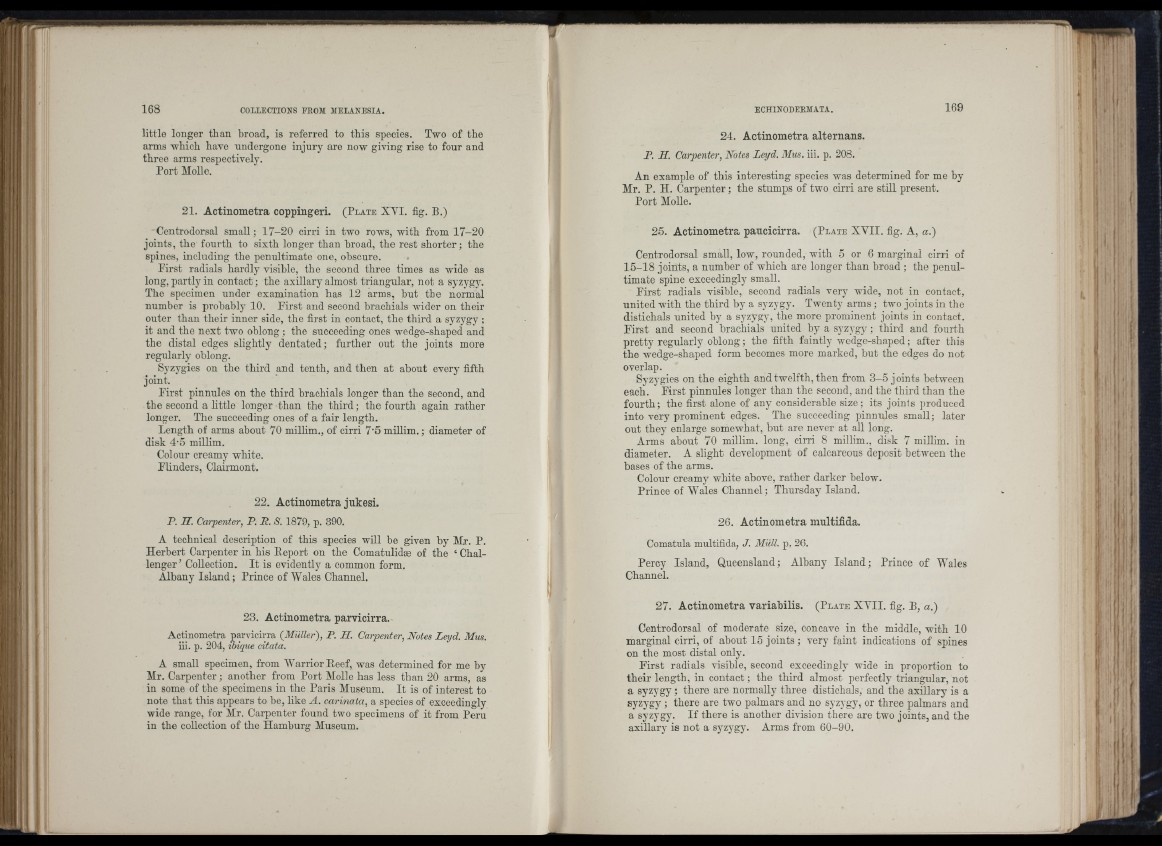
168 COLLECTIONS FKOM MELANESIA.
Ill
little longer than broad, is referred to this species. Two of the
arms which have undergone injury are now giving rise to four and
three arms respectively.
Port Molle.
j
iii 21. Actinometra coppingeri. (P late XYI. fig. B.)
Centrodorsal small; 17-20 cirri in two rows, with from 17-20
joints, the fourth to sixth longer than broad, the rest sh o rte r; the
spines, including the penultimate one, obscure.
First radials hardly visible, the second three times as wide as
long, partly in contact; the axillary almost triangular, not a syzygy.
Tho specimen under examination has 12 arms, but the normal
number is probablj' 10. First and second brachials wider on their
outer than their inner side, the first in contact, the third a syzygy ;
it and the next two oblong; the succeeding ones wedge-shaped and
the distal edges slightly d entated; further out the joints more
regularly oblong.
Syzygies on the third and tenth, and then at about every fifth
joint.
First pinnules on the third brachials longer than the second, and
the second a little longer than the th ird ; the fourth again rather
longer. The succeeding ones of a fair length.
Length of arms about 70 millim., of cirri 7'5 millim.; diameter of
disk 4-5 millim.
Colour creamy white.
Flinders, Clairmont.
22. Actinometra jukesi.
P. H. Carpenter, P. P. S. 1879, p. 390.
A technical description of this species will be given by Mr. P.
Herbert Carpenter in his Report on the Comatulidae of the ‘ Challenger’
Collection. I t is evidently a common form.
Albany Island ; Prince of Wales Channel.
23. Actinometra parvicirra.
Actinometra
ui. p.
netra parvicirra (MiiUer), P. H. Carpenter, Notes Leyd. Mus.
204, ibique citata.
A small specimen, from Warrior Reef, was determined for me by
Mr. Carpenter; another from Port Molle has less than 20 arms, as
in some of the specimens in the Paris Museum. I t is of interest to
note th at this appears to he, like A. carinata, a species of exceedingly
wide range, for Mr. Carpenter found two specimens of it from Peru
in the collection of the Hamburg Museum.
24. Actinometra alternans.
P. H. Carpenter, Notes Leyd. Mus. iii. p. 208.
An example of this interesting species was determined for me by
Mr. P. H. Carpenter; the stumps of two cirri are still present.
Port Molle.
I (■
25. Actinometra paucicirra. (P late XYII. fig. A, a.)
Centrodorsal small, low, rounded, with 5 or 6 marginal cirri of
15-18 joints, a number of which are longer than broad ; the penultimate
spine exceedingly small.
First radials visible, second radials very wide, not in contact,
united with the third by a syzygy. Twenty arms ; two joints in the
distichals united by a syzygy, the more prominent joints in contact.
First and second brachials united by a syzygy ; third and fourth
pretty regularly oblong; the fifth faintly wedge-shaped; after this
the wedge-shaped form becomes more marked, but the edges do not
overlap.
Syzygies on the eighth and twelfth, then from 3 -5 joints between
each. First pinnules longer than the second, and the third than the
fourth; the first alone of any considerable size ; its joints produced
into very prominent edges. The succeeding pinnules small; later
out they enlarge somewhat, hut are never at all long.
Arms about 70 millim. long, cirri 8 millim., disk 7 millim. in
diameter. A slight development of calcareous deposit between the
bases of the arms.
Colour creamy white above, rather darker below.
Prince of Wales Channel; Thursday Island.
26. Actinometra multifida.
Comatula multifida, J. Midi. p. 26.
Percy Island, Queensland; Albany Island; Prince of YAles
Channel.
27. Actinometra variabilis. (P late XY II. fig. B, a.)
Centrodorsal of moderate size, concave in the middle, with 10
marginal cirri, of about 15 jo in ts ; very faint indications of spines
on the most distal only.
F irst radials visible, second exceedingly wide in proportion to
their length, in contact; the third almost perfectly triangular, not
a syzygy; there are normally three distichals, and the axillary is a
syzygy ; there are two palmars and no syzygy, or three palmars and
a syzygy. I f there is another division there are two joints, and the
axillary is not a syzygy. Arms from 60-90.